Microeconomics: Analyzing Consumer Behavior with Utility and Insurance
VerifiedAdded on 2023/06/18
|9
|2528
|387
Essay
AI Summary
This essay delves into microeconomic principles, focusing on expected utility theory and prospect theory within the context of consumer behavior and insurance markets. It examines a consumer's decision-making process in a two-state model, analyzing how individuals make choices under uncertainty and how fair insurance markets function. The essay further explores the concept of loss aversion and bounded rationality, contrasting it with rational behavior. It discusses the value function in prospect theory, emphasizing the role of reference points in shaping risk attitudes. Additionally, it compares the utility function used in prospect theory with the expected utility theory, highlighting the differences in how they model individual preferences and choices under risk and uncertainty. This resource is available on Desklib, a platform offering a wealth of study materials, including past papers and solved assignments, to support students in their academic endeavors.
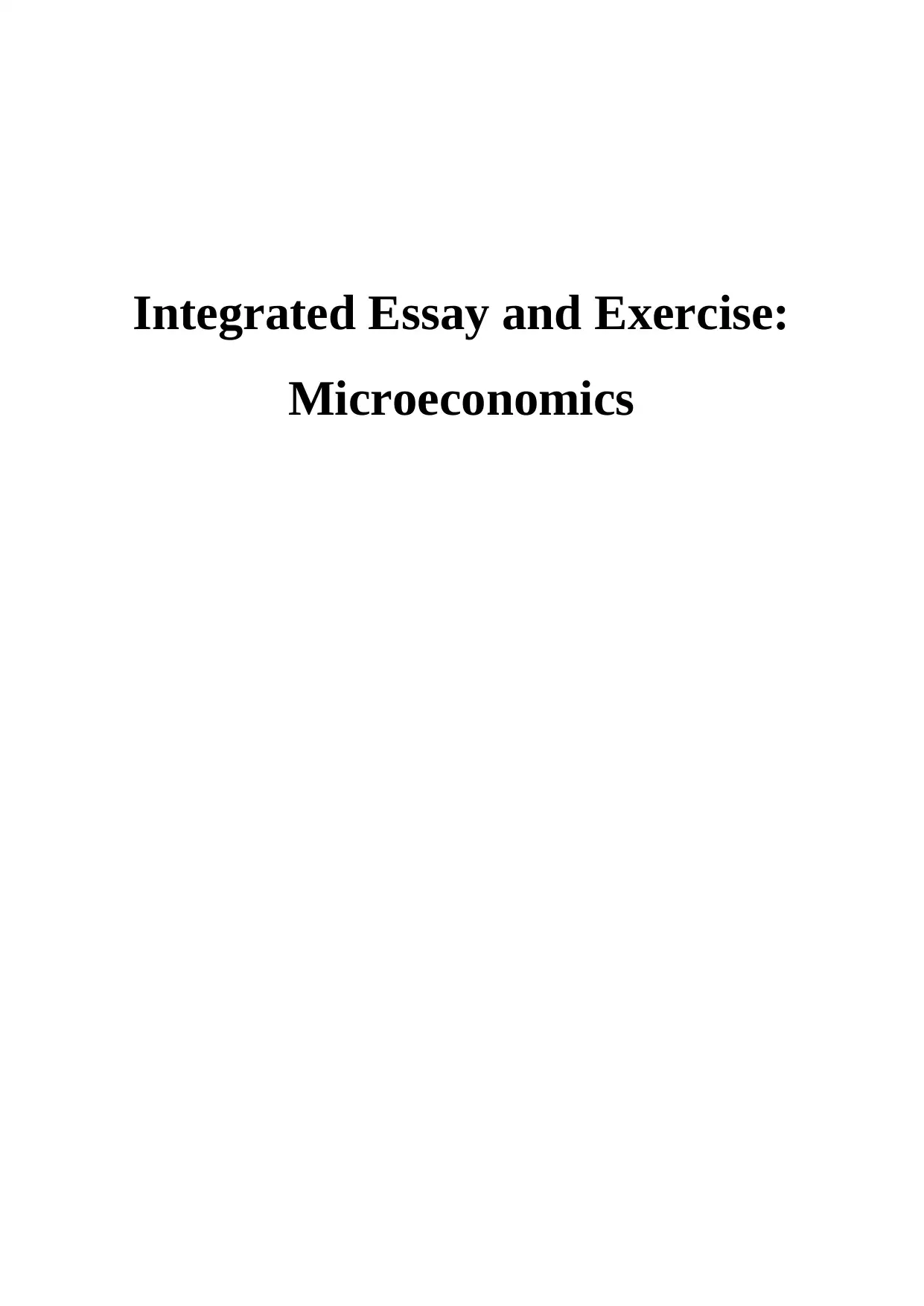
Integrated Essay and Exercise:
Microeconomics
Microeconomics
Paraphrase This Document
Need a fresh take? Get an instant paraphrase of this document with our AI Paraphraser
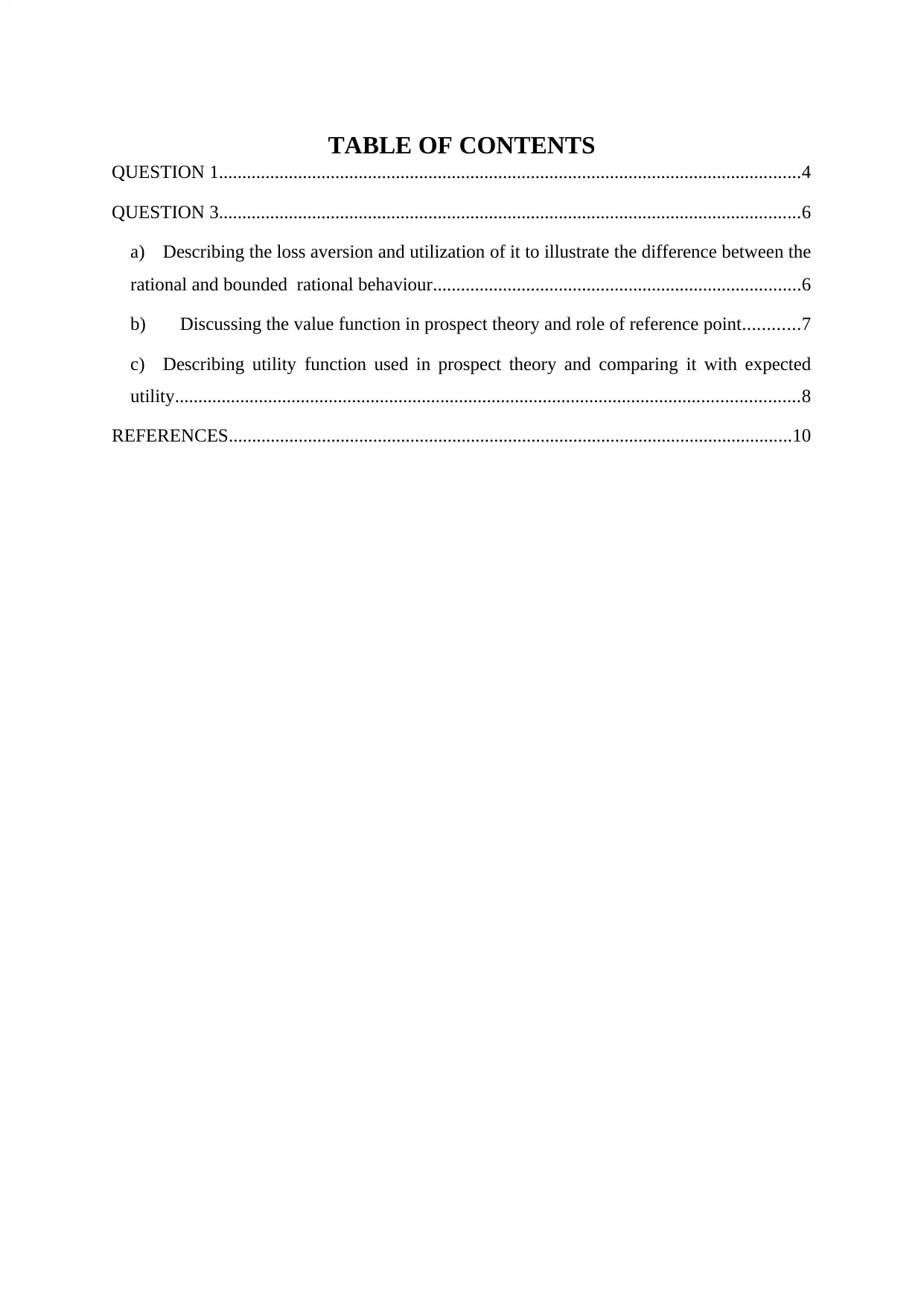
TABLE OF CONTENTS
QUESTION 1.............................................................................................................................4
QUESTION 3.............................................................................................................................6
a) Describing the loss aversion and utilization of it to illustrate the difference between the
rational and bounded rational behaviour...............................................................................6
b) Discussing the value function in prospect theory and role of reference point............7
c) Describing utility function used in prospect theory and comparing it with expected
utility......................................................................................................................................8
REFERENCES.........................................................................................................................10
QUESTION 1.............................................................................................................................4
QUESTION 3.............................................................................................................................6
a) Describing the loss aversion and utilization of it to illustrate the difference between the
rational and bounded rational behaviour...............................................................................6
b) Discussing the value function in prospect theory and role of reference point............7
c) Describing utility function used in prospect theory and comparing it with expected
utility......................................................................................................................................8
REFERENCES.........................................................................................................................10
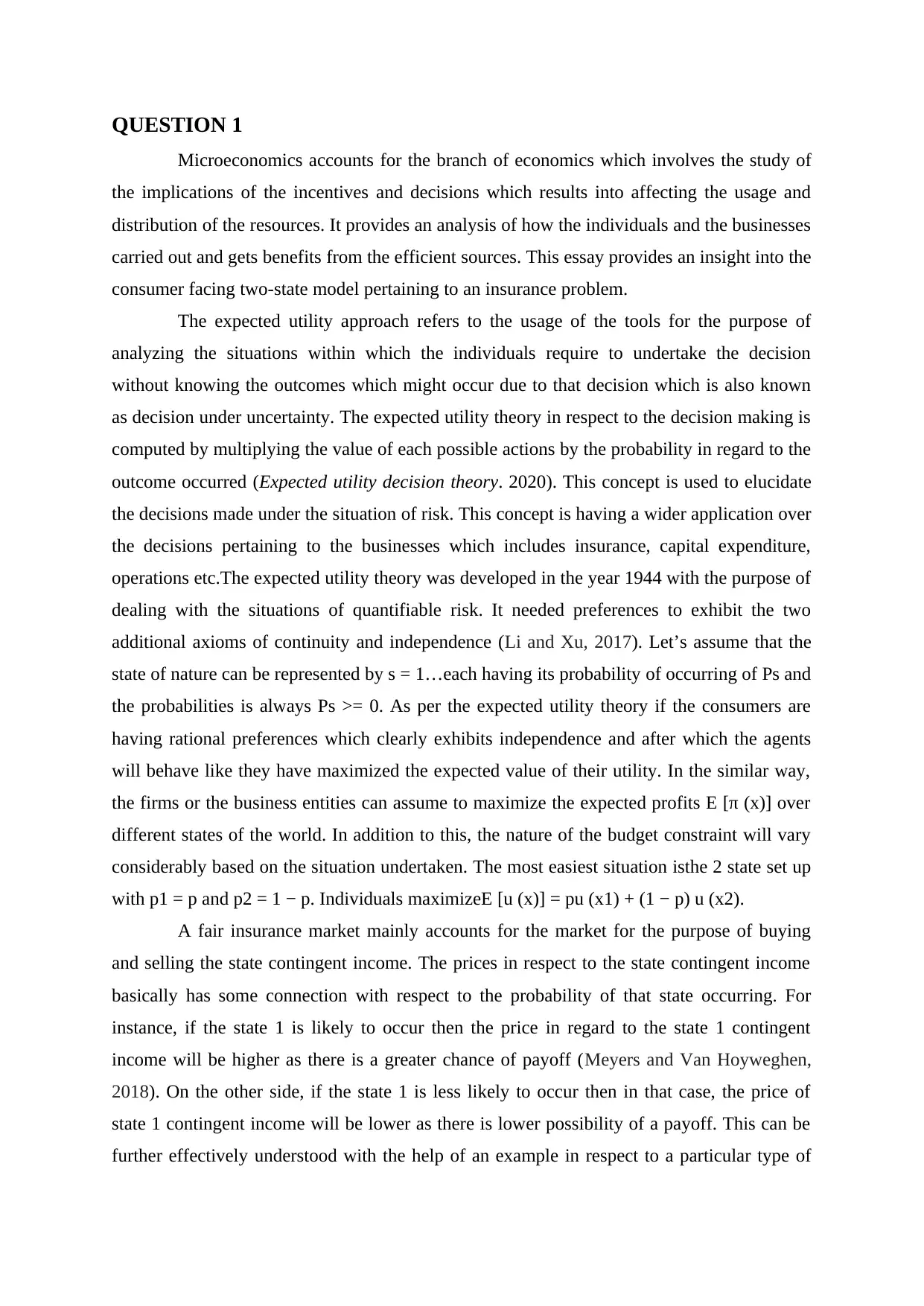
QUESTION 1
Microeconomics accounts for the branch of economics which involves the study of
the implications of the incentives and decisions which results into affecting the usage and
distribution of the resources. It provides an analysis of how the individuals and the businesses
carried out and gets benefits from the efficient sources. This essay provides an insight into the
consumer facing two-state model pertaining to an insurance problem.
The expected utility approach refers to the usage of the tools for the purpose of
analyzing the situations within which the individuals require to undertake the decision
without knowing the outcomes which might occur due to that decision which is also known
as decision under uncertainty. The expected utility theory in respect to the decision making is
computed by multiplying the value of each possible actions by the probability in regard to the
outcome occurred (Expected utility decision theory. 2020). This concept is used to elucidate
the decisions made under the situation of risk. This concept is having a wider application over
the decisions pertaining to the businesses which includes insurance, capital expenditure,
operations etc.The expected utility theory was developed in the year 1944 with the purpose of
dealing with the situations of quantifiable risk. It needed preferences to exhibit the two
additional axioms of continuity and independence (Li and Xu, 2017). Let’s assume that the
state of nature can be represented by s = 1…each having its probability of occurring of Ps and
the probabilities is always Ps >= 0. As per the expected utility theory if the consumers are
having rational preferences which clearly exhibits independence and after which the agents
will behave like they have maximized the expected value of their utility. In the similar way,
the firms or the business entities can assume to maximize the expected profits E [π (x)] over
different states of the world. In addition to this, the nature of the budget constraint will vary
considerably based on the situation undertaken. The most easiest situation isthe 2 state set up
with p1 = p and p2 = 1 − p. Individuals maximizeE [u (x)] = pu (x1) + (1 − p) u (x2).
A fair insurance market mainly accounts for the market for the purpose of buying
and selling the state contingent income. The prices in respect to the state contingent income
basically has some connection with respect to the probability of that state occurring. For
instance, if the state 1 is likely to occur then the price in regard to the state 1 contingent
income will be higher as there is a greater chance of payoff (Meyers and Van Hoyweghen,
2018). On the other side, if the state 1 is less likely to occur then in that case, the price of
state 1 contingent income will be lower as there is lower possibility of a payoff. This can be
further effectively understood with the help of an example in respect to a particular type of
Microeconomics accounts for the branch of economics which involves the study of
the implications of the incentives and decisions which results into affecting the usage and
distribution of the resources. It provides an analysis of how the individuals and the businesses
carried out and gets benefits from the efficient sources. This essay provides an insight into the
consumer facing two-state model pertaining to an insurance problem.
The expected utility approach refers to the usage of the tools for the purpose of
analyzing the situations within which the individuals require to undertake the decision
without knowing the outcomes which might occur due to that decision which is also known
as decision under uncertainty. The expected utility theory in respect to the decision making is
computed by multiplying the value of each possible actions by the probability in regard to the
outcome occurred (Expected utility decision theory. 2020). This concept is used to elucidate
the decisions made under the situation of risk. This concept is having a wider application over
the decisions pertaining to the businesses which includes insurance, capital expenditure,
operations etc.The expected utility theory was developed in the year 1944 with the purpose of
dealing with the situations of quantifiable risk. It needed preferences to exhibit the two
additional axioms of continuity and independence (Li and Xu, 2017). Let’s assume that the
state of nature can be represented by s = 1…each having its probability of occurring of Ps and
the probabilities is always Ps >= 0. As per the expected utility theory if the consumers are
having rational preferences which clearly exhibits independence and after which the agents
will behave like they have maximized the expected value of their utility. In the similar way,
the firms or the business entities can assume to maximize the expected profits E [π (x)] over
different states of the world. In addition to this, the nature of the budget constraint will vary
considerably based on the situation undertaken. The most easiest situation isthe 2 state set up
with p1 = p and p2 = 1 − p. Individuals maximizeE [u (x)] = pu (x1) + (1 − p) u (x2).
A fair insurance market mainly accounts for the market for the purpose of buying
and selling the state contingent income. The prices in respect to the state contingent income
basically has some connection with respect to the probability of that state occurring. For
instance, if the state 1 is likely to occur then the price in regard to the state 1 contingent
income will be higher as there is a greater chance of payoff (Meyers and Van Hoyweghen,
2018). On the other side, if the state 1 is less likely to occur then in that case, the price of
state 1 contingent income will be lower as there is lower possibility of a payoff. This can be
further effectively understood with the help of an example in respect to a particular type of
⊘ This is a preview!⊘
Do you want full access?
Subscribe today to unlock all pages.

Trusted by 1+ million students worldwide
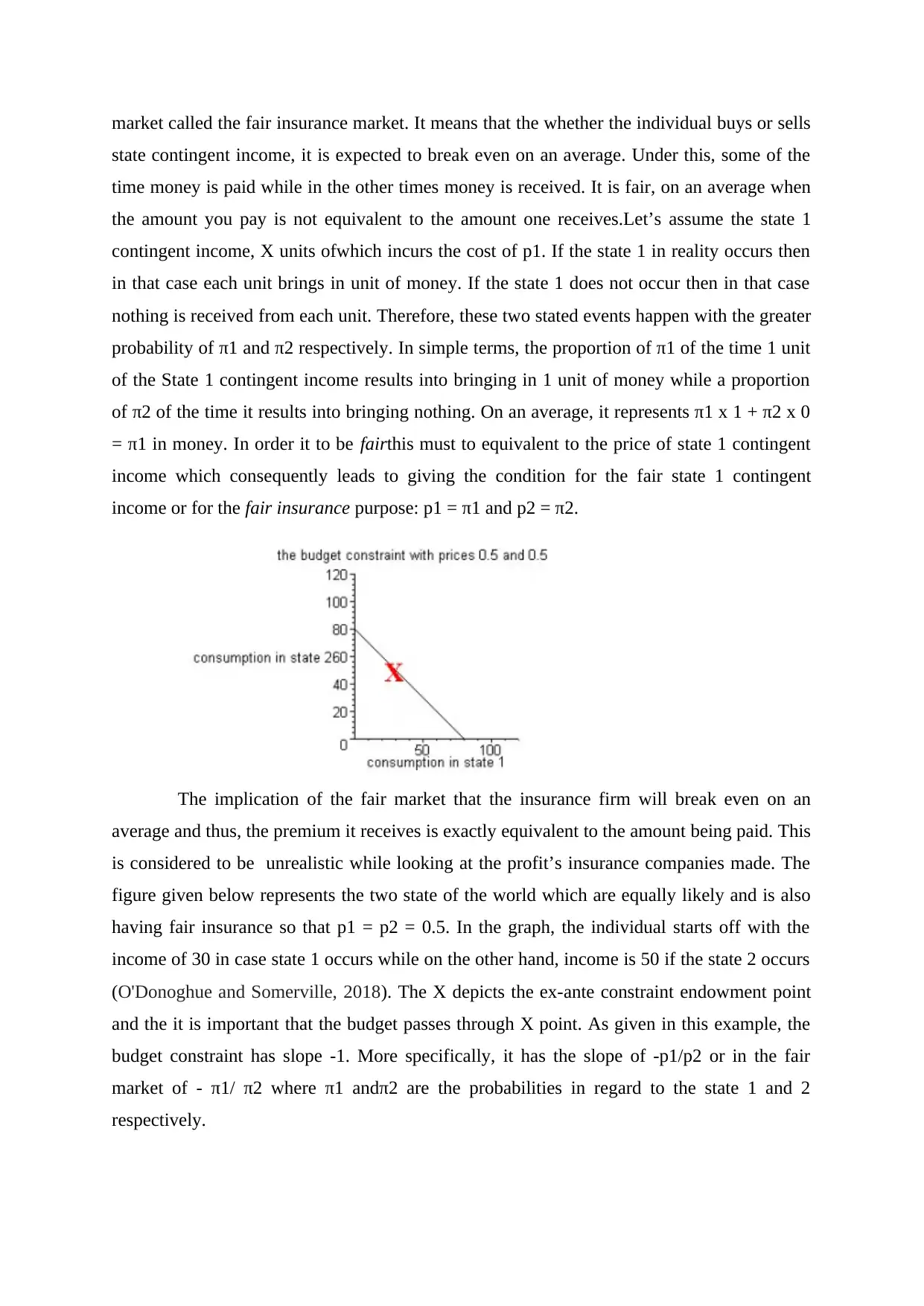
market called the fair insurance market. It means that the whether the individual buys or sells
state contingent income, it is expected to break even on an average. Under this, some of the
time money is paid while in the other times money is received. It is fair, on an average when
the amount you pay is not equivalent to the amount one receives.Let’s assume the state 1
contingent income, X units ofwhich incurs the cost of p1. If the state 1 in reality occurs then
in that case each unit brings in unit of money. If the state 1 does not occur then in that case
nothing is received from each unit. Therefore, these two stated events happen with the greater
probability of π1 and π2 respectively. In simple terms, the proportion of π1 of the time 1 unit
of the State 1 contingent income results into bringing in 1 unit of money while a proportion
of π2 of the time it results into bringing nothing. On an average, it represents π1 x 1 + π2 x 0
= π1 in money. In order it to be fairthis must to equivalent to the price of state 1 contingent
income which consequently leads to giving the condition for the fair state 1 contingent
income or for the fair insurance purpose: p1 = π1 and p2 = π2.
The implication of the fair market that the insurance firm will break even on an
average and thus, the premium it receives is exactly equivalent to the amount being paid. This
is considered to be unrealistic while looking at the profit’s insurance companies made. The
figure given below represents the two state of the world which are equally likely and is also
having fair insurance so that p1 = p2 = 0.5. In the graph, the individual starts off with the
income of 30 in case state 1 occurs while on the other hand, income is 50 if the state 2 occurs
(O'Donoghue and Somerville, 2018). The X depicts the ex-ante constraint endowment point
and the it is important that the budget passes through X point. As given in this example, the
budget constraint has slope -1. More specifically, it has the slope of -p1/p2 or in the fair
market of - π1/ π2 where π1 andπ2 are the probabilities in regard to the state 1 and 2
respectively.
state contingent income, it is expected to break even on an average. Under this, some of the
time money is paid while in the other times money is received. It is fair, on an average when
the amount you pay is not equivalent to the amount one receives.Let’s assume the state 1
contingent income, X units ofwhich incurs the cost of p1. If the state 1 in reality occurs then
in that case each unit brings in unit of money. If the state 1 does not occur then in that case
nothing is received from each unit. Therefore, these two stated events happen with the greater
probability of π1 and π2 respectively. In simple terms, the proportion of π1 of the time 1 unit
of the State 1 contingent income results into bringing in 1 unit of money while a proportion
of π2 of the time it results into bringing nothing. On an average, it represents π1 x 1 + π2 x 0
= π1 in money. In order it to be fairthis must to equivalent to the price of state 1 contingent
income which consequently leads to giving the condition for the fair state 1 contingent
income or for the fair insurance purpose: p1 = π1 and p2 = π2.
The implication of the fair market that the insurance firm will break even on an
average and thus, the premium it receives is exactly equivalent to the amount being paid. This
is considered to be unrealistic while looking at the profit’s insurance companies made. The
figure given below represents the two state of the world which are equally likely and is also
having fair insurance so that p1 = p2 = 0.5. In the graph, the individual starts off with the
income of 30 in case state 1 occurs while on the other hand, income is 50 if the state 2 occurs
(O'Donoghue and Somerville, 2018). The X depicts the ex-ante constraint endowment point
and the it is important that the budget passes through X point. As given in this example, the
budget constraint has slope -1. More specifically, it has the slope of -p1/p2 or in the fair
market of - π1/ π2 where π1 andπ2 are the probabilities in regard to the state 1 and 2
respectively.
Paraphrase This Document
Need a fresh take? Get an instant paraphrase of this document with our AI Paraphraser
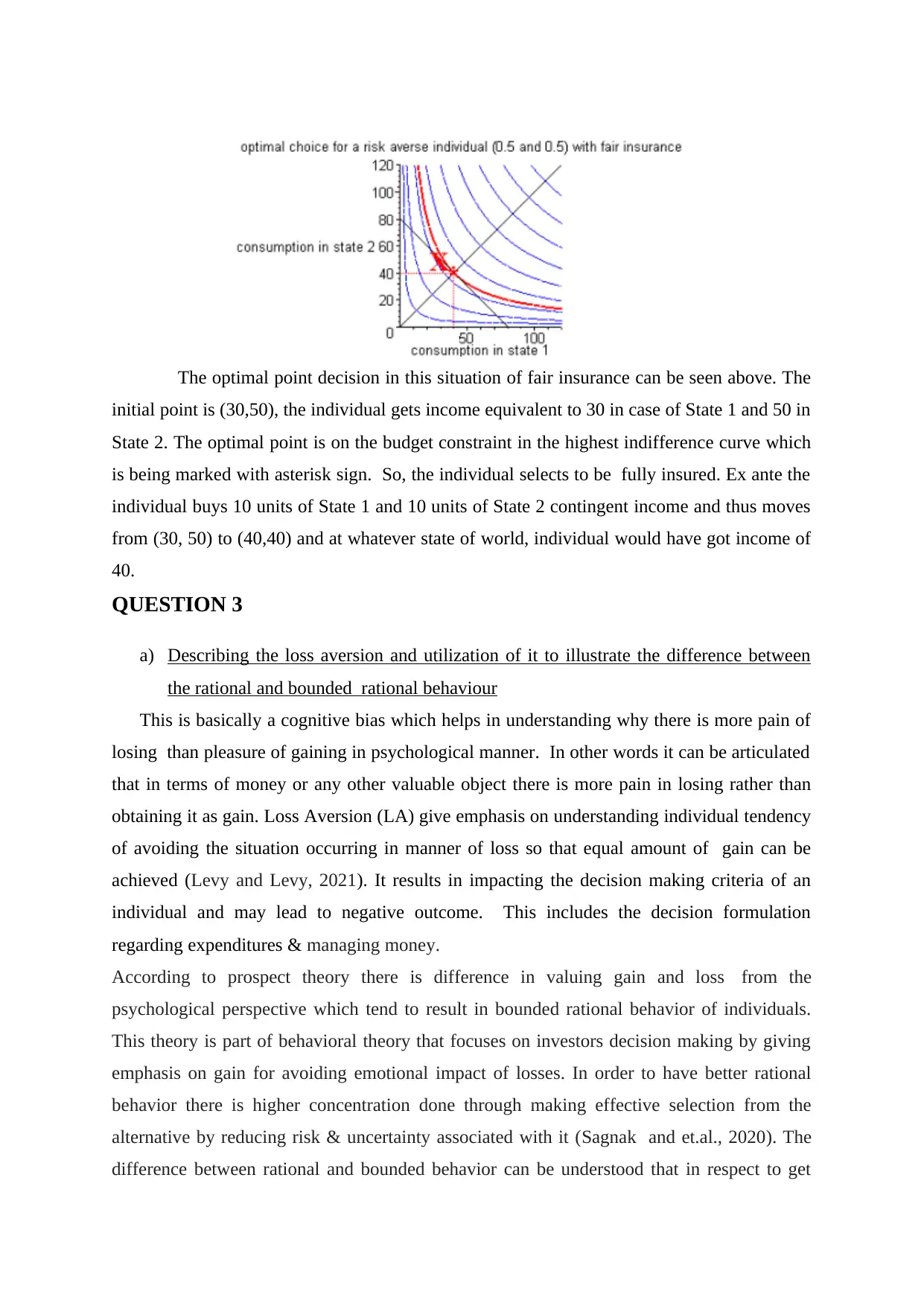
The optimal point decision in this situation of fair insurance can be seen above. The
initial point is (30,50), the individual gets income equivalent to 30 in case of State 1 and 50 in
State 2. The optimal point is on the budget constraint in the highest indifference curve which
is being marked with asterisk sign. So, the individual selects to be fully insured. Ex ante the
individual buys 10 units of State 1 and 10 units of State 2 contingent income and thus moves
from (30, 50) to (40,40) and at whatever state of world, individual would have got income of
40.
QUESTION 3
a) Describing the loss aversion and utilization of it to illustrate the difference between
the rational and bounded rational behaviour
This is basically a cognitive bias which helps in understanding why there is more pain of
losing than pleasure of gaining in psychological manner. In other words it can be articulated
that in terms of money or any other valuable object there is more pain in losing rather than
obtaining it as gain. Loss Aversion (LA) give emphasis on understanding individual tendency
of avoiding the situation occurring in manner of loss so that equal amount of gain can be
achieved (Levy and Levy, 2021). It results in impacting the decision making criteria of an
individual and may lead to negative outcome. This includes the decision formulation
regarding expenditures & managing money.
According to prospect theory there is difference in valuing gain and loss from the
psychological perspective which tend to result in bounded rational behavior of individuals.
This theory is part of behavioral theory that focuses on investors decision making by giving
emphasis on gain for avoiding emotional impact of losses. In order to have better rational
behavior there is higher concentration done through making effective selection from the
alternative by reducing risk & uncertainty associated with it (Sagnak and et.al., 2020). The
difference between rational and bounded behavior can be understood that in respect to get
initial point is (30,50), the individual gets income equivalent to 30 in case of State 1 and 50 in
State 2. The optimal point is on the budget constraint in the highest indifference curve which
is being marked with asterisk sign. So, the individual selects to be fully insured. Ex ante the
individual buys 10 units of State 1 and 10 units of State 2 contingent income and thus moves
from (30, 50) to (40,40) and at whatever state of world, individual would have got income of
40.
QUESTION 3
a) Describing the loss aversion and utilization of it to illustrate the difference between
the rational and bounded rational behaviour
This is basically a cognitive bias which helps in understanding why there is more pain of
losing than pleasure of gaining in psychological manner. In other words it can be articulated
that in terms of money or any other valuable object there is more pain in losing rather than
obtaining it as gain. Loss Aversion (LA) give emphasis on understanding individual tendency
of avoiding the situation occurring in manner of loss so that equal amount of gain can be
achieved (Levy and Levy, 2021). It results in impacting the decision making criteria of an
individual and may lead to negative outcome. This includes the decision formulation
regarding expenditures & managing money.
According to prospect theory there is difference in valuing gain and loss from the
psychological perspective which tend to result in bounded rational behavior of individuals.
This theory is part of behavioral theory that focuses on investors decision making by giving
emphasis on gain for avoiding emotional impact of losses. In order to have better rational
behavior there is higher concentration done through making effective selection from the
alternative by reducing risk & uncertainty associated with it (Sagnak and et.al., 2020). The
difference between rational and bounded behavior can be understood that in respect to get
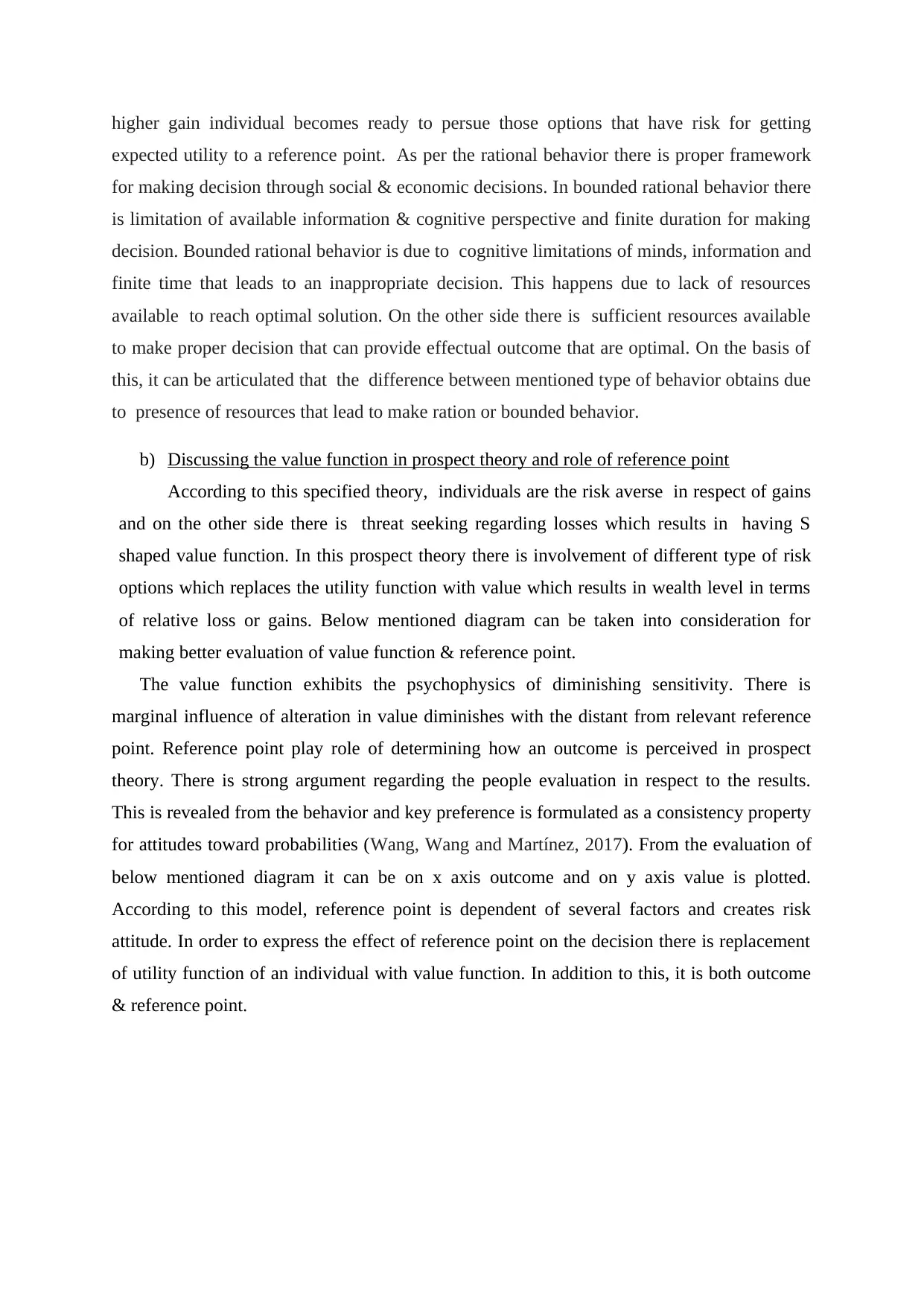
higher gain individual becomes ready to persue those options that have risk for getting
expected utility to a reference point. As per the rational behavior there is proper framework
for making decision through social & economic decisions. In bounded rational behavior there
is limitation of available information & cognitive perspective and finite duration for making
decision. Bounded rational behavior is due to cognitive limitations of minds, information and
finite time that leads to an inappropriate decision. This happens due to lack of resources
available to reach optimal solution. On the other side there is sufficient resources available
to make proper decision that can provide effectual outcome that are optimal. On the basis of
this, it can be articulated that the difference between mentioned type of behavior obtains due
to presence of resources that lead to make ration or bounded behavior.
b) Discussing the value function in prospect theory and role of reference point
According to this specified theory, individuals are the risk averse in respect of gains
and on the other side there is threat seeking regarding losses which results in having S
shaped value function. In this prospect theory there is involvement of different type of risk
options which replaces the utility function with value which results in wealth level in terms
of relative loss or gains. Below mentioned diagram can be taken into consideration for
making better evaluation of value function & reference point.
The value function exhibits the psychophysics of diminishing sensitivity. There is
marginal influence of alteration in value diminishes with the distant from relevant reference
point. Reference point play role of determining how an outcome is perceived in prospect
theory. There is strong argument regarding the people evaluation in respect to the results.
This is revealed from the behavior and key preference is formulated as a consistency property
for attitudes toward probabilities (Wang, Wang and Martínez, 2017). From the evaluation of
below mentioned diagram it can be on x axis outcome and on y axis value is plotted.
According to this model, reference point is dependent of several factors and creates risk
attitude. In order to express the effect of reference point on the decision there is replacement
of utility function of an individual with value function. In addition to this, it is both outcome
& reference point.
expected utility to a reference point. As per the rational behavior there is proper framework
for making decision through social & economic decisions. In bounded rational behavior there
is limitation of available information & cognitive perspective and finite duration for making
decision. Bounded rational behavior is due to cognitive limitations of minds, information and
finite time that leads to an inappropriate decision. This happens due to lack of resources
available to reach optimal solution. On the other side there is sufficient resources available
to make proper decision that can provide effectual outcome that are optimal. On the basis of
this, it can be articulated that the difference between mentioned type of behavior obtains due
to presence of resources that lead to make ration or bounded behavior.
b) Discussing the value function in prospect theory and role of reference point
According to this specified theory, individuals are the risk averse in respect of gains
and on the other side there is threat seeking regarding losses which results in having S
shaped value function. In this prospect theory there is involvement of different type of risk
options which replaces the utility function with value which results in wealth level in terms
of relative loss or gains. Below mentioned diagram can be taken into consideration for
making better evaluation of value function & reference point.
The value function exhibits the psychophysics of diminishing sensitivity. There is
marginal influence of alteration in value diminishes with the distant from relevant reference
point. Reference point play role of determining how an outcome is perceived in prospect
theory. There is strong argument regarding the people evaluation in respect to the results.
This is revealed from the behavior and key preference is formulated as a consistency property
for attitudes toward probabilities (Wang, Wang and Martínez, 2017). From the evaluation of
below mentioned diagram it can be on x axis outcome and on y axis value is plotted.
According to this model, reference point is dependent of several factors and creates risk
attitude. In order to express the effect of reference point on the decision there is replacement
of utility function of an individual with value function. In addition to this, it is both outcome
& reference point.
⊘ This is a preview!⊘
Do you want full access?
Subscribe today to unlock all pages.

Trusted by 1+ million students worldwide

Expected value is the total of products of several utilities and their concerned
probabilities (Wang and et.al., 2020). According to von Neumann Morgenstern utility index
in expected utility consumers are rank the items in terms of priorities so it will be conditioned
by their probabilities of occurrence. On the other side, value function of prospect theory
implies risk aversion for gains but risk seekers for losses. On the basis of this, extension
between both can be understood properly.
c) Describing utility function used in prospect theory and comparing it with expected
utility
Utility function in prospect theory is used to present the preference of a person for set of
outcome. It is concerned with larger value to outcome which is more preferable to an
individual than other options. In addition to this, expected utility that is an entity which is
desired to reach any number of scenarios. Expected Utility (EU) is calculated by taking
weighted average of all possible outcome under certain circumstances. There is involvement
of idea that people tend to overreact to small probability event and under react in reverse
situation.
Prospect theory is part of behavioral model which emphasis on the obtaining utility
through making decision regarding risk related to gain & losses. This concentrates on the
behavior of investors by evaluation reaction in respect to outcome deriving from the
formulated decision. In this Utility Function (UF), model aims to describe actual behavior of
people. In contractor to this, expected utility theory provides knowledge regarding decision
that are perfectly rational (Wang and et.al., 2018). The basic difference between the
probabilities (Wang and et.al., 2020). According to von Neumann Morgenstern utility index
in expected utility consumers are rank the items in terms of priorities so it will be conditioned
by their probabilities of occurrence. On the other side, value function of prospect theory
implies risk aversion for gains but risk seekers for losses. On the basis of this, extension
between both can be understood properly.
c) Describing utility function used in prospect theory and comparing it with expected
utility
Utility function in prospect theory is used to present the preference of a person for set of
outcome. It is concerned with larger value to outcome which is more preferable to an
individual than other options. In addition to this, expected utility that is an entity which is
desired to reach any number of scenarios. Expected Utility (EU) is calculated by taking
weighted average of all possible outcome under certain circumstances. There is involvement
of idea that people tend to overreact to small probability event and under react in reverse
situation.
Prospect theory is part of behavioral model which emphasis on the obtaining utility
through making decision regarding risk related to gain & losses. This concentrates on the
behavior of investors by evaluation reaction in respect to outcome deriving from the
formulated decision. In this Utility Function (UF), model aims to describe actual behavior of
people. In contractor to this, expected utility theory provides knowledge regarding decision
that are perfectly rational (Wang and et.al., 2018). The basic difference between the
Paraphrase This Document
Need a fresh take? Get an instant paraphrase of this document with our AI Paraphraser
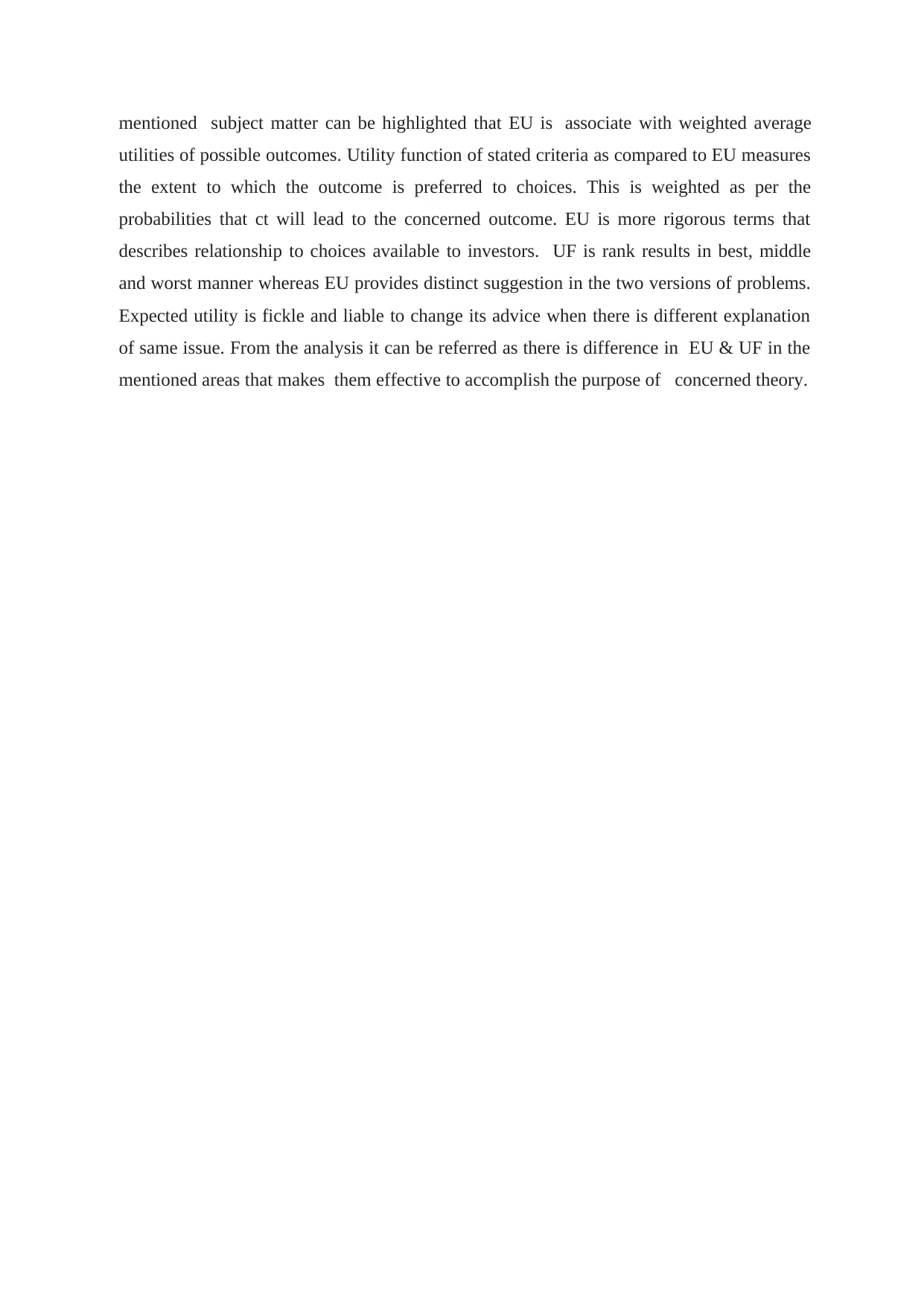
mentioned subject matter can be highlighted that EU is associate with weighted average
utilities of possible outcomes. Utility function of stated criteria as compared to EU measures
the extent to which the outcome is preferred to choices. This is weighted as per the
probabilities that ct will lead to the concerned outcome. EU is more rigorous terms that
describes relationship to choices available to investors. UF is rank results in best, middle
and worst manner whereas EU provides distinct suggestion in the two versions of problems.
Expected utility is fickle and liable to change its advice when there is different explanation
of same issue. From the analysis it can be referred as there is difference in EU & UF in the
mentioned areas that makes them effective to accomplish the purpose of concerned theory.
utilities of possible outcomes. Utility function of stated criteria as compared to EU measures
the extent to which the outcome is preferred to choices. This is weighted as per the
probabilities that ct will lead to the concerned outcome. EU is more rigorous terms that
describes relationship to choices available to investors. UF is rank results in best, middle
and worst manner whereas EU provides distinct suggestion in the two versions of problems.
Expected utility is fickle and liable to change its advice when there is different explanation
of same issue. From the analysis it can be referred as there is difference in EU & UF in the
mentioned areas that makes them effective to accomplish the purpose of concerned theory.
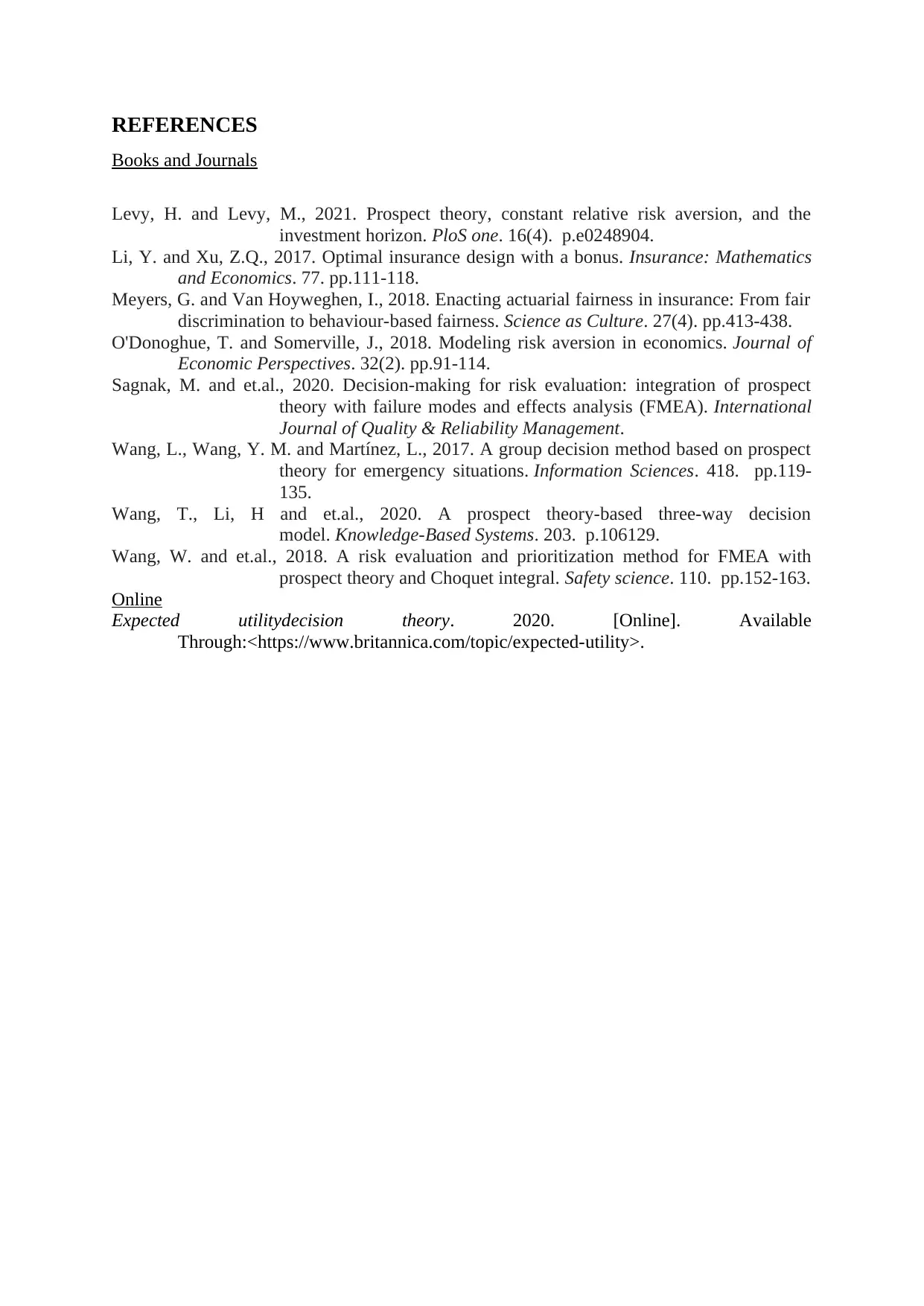
REFERENCES
Books and Journals
Levy, H. and Levy, M., 2021. Prospect theory, constant relative risk aversion, and the
investment horizon. PloS one. 16(4). p.e0248904.
Li, Y. and Xu, Z.Q., 2017. Optimal insurance design with a bonus. Insurance: Mathematics
and Economics. 77. pp.111-118.
Meyers, G. and Van Hoyweghen, I., 2018. Enacting actuarial fairness in insurance: From fair
discrimination to behaviour-based fairness. Science as Culture. 27(4). pp.413-438.
O'Donoghue, T. and Somerville, J., 2018. Modeling risk aversion in economics. Journal of
Economic Perspectives. 32(2). pp.91-114.
Sagnak, M. and et.al., 2020. Decision-making for risk evaluation: integration of prospect
theory with failure modes and effects analysis (FMEA). International
Journal of Quality & Reliability Management.
Wang, L., Wang, Y. M. and Martínez, L., 2017. A group decision method based on prospect
theory for emergency situations. Information Sciences. 418. pp.119-
135.
Wang, T., Li, H and et.al., 2020. A prospect theory-based three-way decision
model. Knowledge-Based Systems. 203. p.106129.
Wang, W. and et.al., 2018. A risk evaluation and prioritization method for FMEA with
prospect theory and Choquet integral. Safety science. 110. pp.152-163.
Online
Expected utilitydecision theory. 2020. [Online]. Available
Through:<https://www.britannica.com/topic/expected-utility>.
Books and Journals
Levy, H. and Levy, M., 2021. Prospect theory, constant relative risk aversion, and the
investment horizon. PloS one. 16(4). p.e0248904.
Li, Y. and Xu, Z.Q., 2017. Optimal insurance design with a bonus. Insurance: Mathematics
and Economics. 77. pp.111-118.
Meyers, G. and Van Hoyweghen, I., 2018. Enacting actuarial fairness in insurance: From fair
discrimination to behaviour-based fairness. Science as Culture. 27(4). pp.413-438.
O'Donoghue, T. and Somerville, J., 2018. Modeling risk aversion in economics. Journal of
Economic Perspectives. 32(2). pp.91-114.
Sagnak, M. and et.al., 2020. Decision-making for risk evaluation: integration of prospect
theory with failure modes and effects analysis (FMEA). International
Journal of Quality & Reliability Management.
Wang, L., Wang, Y. M. and Martínez, L., 2017. A group decision method based on prospect
theory for emergency situations. Information Sciences. 418. pp.119-
135.
Wang, T., Li, H and et.al., 2020. A prospect theory-based three-way decision
model. Knowledge-Based Systems. 203. p.106129.
Wang, W. and et.al., 2018. A risk evaluation and prioritization method for FMEA with
prospect theory and Choquet integral. Safety science. 110. pp.152-163.
Online
Expected utilitydecision theory. 2020. [Online]. Available
Through:<https://www.britannica.com/topic/expected-utility>.
⊘ This is a preview!⊘
Do you want full access?
Subscribe today to unlock all pages.

Trusted by 1+ million students worldwide
1 out of 9
Your All-in-One AI-Powered Toolkit for Academic Success.
+13062052269
info@desklib.com
Available 24*7 on WhatsApp / Email
![[object Object]](/_next/static/media/star-bottom.7253800d.svg)
Unlock your academic potential
Copyright © 2020–2025 A2Z Services. All Rights Reserved. Developed and managed by ZUCOL.